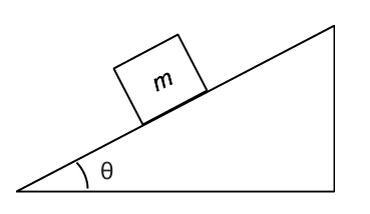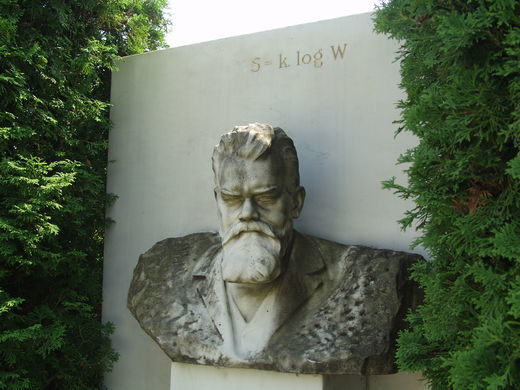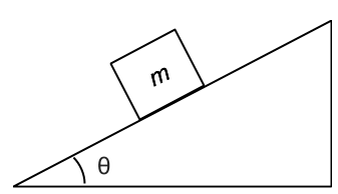I am forever indebted to Clyfe Beckwith, my high-school physics teacher. Not because he taught us mechanics, but because he used mechanics to teach us about the power and plasticity of conceptual frames.[1]
We were learning to think about things like energy and forces, about how objects move in space and on inclines and around curves (fear winces before tucking myself into a ball to go down a hill on cross-country skis are always accompanied by ironic inside-my-mind jabs yammering “your instincts suck-if your center of gravity is lower to the ground you’ll have an easier time combatting the conservation of angular momentum”). Learning to think about images like this one:

The task here is to decompose the various forces that act on the object, recompose them into some net force, and then use this net force to describe how the block will accelerate down the inclined plane.
I remember the first step to tally the forces was easy. Gravity will pull the block down because that’s what gravity does. Friction will slow the block down because that’s what friction does. And then there’s this force we think less about in our day-to-day lives called the normal force, a contact force that surfaces exert to prevent solid objects from passing through each other. The solids-declaring-their-identity-as-not-air-and-not-ghosts force. And that’s gonna live at the fault line between the objects, concentrating its force-hands into the object’s back like a lover.
The problem is that, because the plane is inclined and not flat, these forces have directionality. They don’t all move up and down. Some move up and down and others are on a diagonal.
I remember feeling flummoxed because it was impossible to get them to align nicely into the perpendicular x-y axes of the Cartesian plane. In my mind, given the math I’d studied up to that point (so, like, high-school algebra-I taught myself trigonometry over the summer but because I had taught myself never had the voiceover that this would be a tool for solving physics problems), Cartesian planes were things, objects as stiff as blocks, things that existed in one frame of reference, perfectly up and perfectly down, not a smidgen of Sharpie ink bleeding or wavering on the axis lines.
And then Clyfe Beckwith did something radical. He tilted the Cartesian plane so that it matched the angle of the incline.
I was like, you can’t do that.
He was like, why not?
I was like, because planes don’t tilt like that, because they exist in the rigid confines of up and down, of one single perpendicular, because that’s how the world works, because this is the static frame of reference I’ve learned about and used again and again and again to solve all these Euclidean geometry problems from freshman year, because Bill Scott, my freshman math teacher, is great, love the guy, and how can we question the mental habits he helped me build to solve those problems, because, wait, really, you can do that?
He was like, just try it.
I remember his cheshire cat smile, illuminated by the joy of palpably watching a student’s mind expand before his eyes, palpably seeing a shift that was one small step for man but a giant step for Mankind, something as abstract as a block moving on an inclined plane teaching a lesson about the malleability of thinking tools.
We tried it. We tilted our heads to theta. We decomposed gravity into two vectors, one countering the normal force and the other moving along the plane. We empathized with the normal force, saw the world from its perspective, not our own. What was intractable became simple. The math became easy.
This may seem obtuse and irrelevant. Stuff you haven’t thought about since high school. Forget about the physics. Focus on tilting your head to theta. Focus on the fact that there is nothing native or natural about assuming that Cartesian planes exist in some idealized perpendicular realm that must always start from up and down, that this disposition is the side effect of drawing them on a piece of paper oriented towards our own front-facing perspective. That it’s possible to empathize with the perspective of a block of mass m at a spot on a triangle tilted at angle theta to make it easier to solve a problem. And that this problem itself is only an approximation upon an approximation upon an approximation, gravity and friction acting at some idealized center to make it easier to do the math, integrating all the infinite smaller forces up through some idealized continuum. Stuff they don’t say much about in high school as that’s the time for building problem-solving muscles. Saving the dissolution for the appropriate moment.
Reading Carlo Rovelli’s The Order of Time pulled this memory out of storage. In his stunningly lyrical book, Rovelli explains how many (with a few variations depending on theory) physicists conceptualize quantum time as radically different from the linear, forward-marching-so-that-the-past-matters-our-actions-matter-choices-are-engraved-and-shape-the-landscape-of-future-possibilities-and-make-morality-possible flow of time we experience in our subjectivity. When we get quantum, explains Rovelli, the difference between past and future blur, phenomena appear that, like the ever-flitting molecules in a glass of water, seem static when viewed through the blunt approximations our eyes provide us so we can navigate the world without going insane from a thermodynamic onslaught.

Rovelli reminds his reader that the idea of an absolute, independent variable time (which shows up in equations as a little t)-time independent of space, time outside the entangled space waltz of Wall-E and Eva, lovers saddened by age’s syncopation, death puncturing our emotional equilibrium to cleave entropy into the pits of our emotions, fraying the trampoline pad into the kinetic energy of springs-that this time is but a mental fiction Newton created within the framework of his theory of the universe, but that the mental landscape of this giant standing upon the shoulders of giants became so prominent in our culture that his view of the world became the view we all inherit and learn when we go to grammar school, became the way the world seems to be, became a fixture as seemingly natural as our experience that the Sun revolves around the Earth, and not otherwise. That the ideas are so ingrained that it takes patience and an open mind to notice that Aristotle talks about time much differently, that, for Aristotle, time was an index of the change relative to two objects. Consider the layers of complexity: how careful we have to be not to read an ancient text with the tinted glasses of today’s concepts, how open and imaginative we must remain to try to understand the text relative to its time as opposed to critiquing the arguments with our own baggage and assumptions; how incredible it is to think that this notion of absolute time, so ingrained that it felt like blasphemy to tilt the Cartesian plane to theta, is but the inheritance of Newton’s ideas, rejected by Leibniz as fitfully as Newton’s crazy idea that objects could influence one another from a distance[2]; how liberating to return to relativity, to experience the universe without the static restrictions of absolute time, to free even the self from the heavy shackles of personhood and identity and recognize we are nothing but socialite Bedouins migrating through the parameters of personality as we mirror approval and flee frowns, the self become array, traits and feelings and thoughts activated through contact with a lover, a family, a team, an organization, a city, a nation, all these concentric circles pitching abstractions that dissolve into the sweat beads of an embrace, of attention swallowed intact by the heartbeat of another.
But it’s not just mechanics. It’s not just time.
It can be the carapace we inherit as we hurt our way through childhood and adolescence, little protective walls of habitual reactions that ossify into detrimental and useless thoughts like the cobwebbed inheritance of celibacy.[3] It can be reactions to situations and events that don’t serve us, that keep us back, anxiety that silences us from speaking up, that fears judgment if we ask a question when we don’t fully understand, interpretations of events in the narratives we’ve constructed to weave our way through life that, importantly, we can choose to keep or discard.
Perhaps the most liberating aspect of Buddhist philosophy is the idea that we have an organ that senses thoughts just like we have organs that sense smells, sounds, tastes, and touch.[4] Separating the self from the stuff of thoughts and emotions is not trivial. We lose the anchor of the noun, abandon the grounding of some thing, no matter how abstract and fleeting thoughts or the pulse of emotions may be (or perhaps they’re not so fleeting? perhaps the incantatory habit of neural patterns in our brains is where we clamp on to remain steadfast amidst rough waves beating life shores?). But this notion of the self as thought is also a conceptual relic we can break, the perpendicular plane we can migrate to theta to help us solve problems and empathize more deeply with another.
There is a calm that arises when we abstract away from the seat of identity as a self separate from the world and up into a view of self as part of the world, as one with the coffee cup accompanying me as I write this post, one with the sun rising into yellow, shifting shades in the summer morning, one with the plastic armchairs and the basil plant, one with my partner as he sleeps thousands of miles away in San Francisco, as I dream with him, recovering legs intertwined in beds and on camp grounds. One with colleagues. One with homeless strangers on the street, one with their pain, their cold, the dirt washed from their face and feet when they shower.
The conceptual carapaces that bind us aren’t required, are often just inherited abstractions from the past. We can discard them if they don’t serve us. We have the ability, always, to tilt our head to theta and breath into the rhythms of the world.
[1] Clyfe radiates kindness. He has that special George Smith superpower of identifying where he can stretch his students just beyond what they believe they’re capable of while imbuing them with the confidence they need to succeed. Clyfe also found it hilarious that I took intro to cosmology, basically about memorizing constellations, after taking AP physics, which was pretty challenging. But I loved schematizing the sky! It added wonder and nostalgia to the science. I gifted Clyfe The Hobbit once, for his sons. I picked that book because my dad loves Tolkien and reading The Hobbit and The Lord of the Rings were rights of passage when I was a child, so I figured they should be for every child. I guess that means there was something in the way Clyfe behaved that pegged him as a great Dad in my mind. Every few years, my dad gets excited about possibility that he may have finally forgotten details in The Lord of the Rings, eager to reread it and discover it as if it were for the first time. But he’s consistently disappointed. He and my brother have astonishing recall; it’s as if every detail of a book or movie has been branded into their brains indefinitely. My brother can query his Alexandrian brain database of movie references to build social bridges, connecting with people through the common token of some reference as opposed to divulging personal anecdote. My mom and I are the opposite. I remember abstractions in my Peircean plague of being a mere table of contents alongside the vivid, vital particularity of narrative minds like that of my colleague Tyler Schnoebelen. When I think back to my freshman year in college, I clearly remember the layout of arguments in Kant’s First Critique and clearly remember the first time I knowingly proved something using induction, and while I clearly remember that I read Anna Karenina and The Death of Ivan Ilyich that year (apparently was in a Tolstoy kind of mood), I cannot remember the details of those narratives. Instead, I recall the emotions I experienced while reading them, as if they get distilled to their essence, the details of what happens to the characters resolved to the moral like in a fable by Aesop. Except not quite. It’s more that the novels transform into signposts for my own narrative, my own life. Portals that open my memory to recover happenings I haven’t recollected for years, 15 years, 20 years, the white-gloved hand of memory swiping off attic dust to unveil grandma’s doilies or gold-rimmed art deco china. My mind pronounces “the Death of Ivan Ilyich” and what comes forth are the feelings of shyness, of rugged anticipation, as I walked up Rush Street in Chicago floating on a cloud of dopamine brimming with anticipatory possibility, on my way to meet the young man who would become my first real boyfriend, hormones coaxed by how I saw him, how he was much more than a person, how something about how he looked and talked and acted elevated him to the perfect boyfriend, which, of course, gave me solace that I was living life as I was supposed to. My memory not recall, but windows with Dali curtains that open and shut into arabesques of identity (see featured image), cards shuffling glimpses of clubs and spades as they disappear, just barely observed, back into the stack. Possibility not actually reserved for the future, but waiting under war helmets in trench wormholes ready for new interpretation. For yes, there was other guy I didn’t decide to date, the guy who told me I looked like Audrey Hepburn (not because I do, but because I do just enough and want to so evidently enough that the flattery makes sense) when he took me on our first date at the top of the Hancock tower, a high-in-the-sky type of bar, full of women with hair stiffed in hairspray and almost acrylic polyester dresses that were made today but always remind you of Scarface or Miami Vice, with the particular smell only high-in-the-sky bars have, stale in a way that’s different from the acrid smell of dive bars that haven’t been cleaned well, maybe it’s the sauce they use on the $50 lamb chops, the jellied mint, the shrimp cocktails alongside the gin, or the cleaning agent reserved exclusively for high-in-the-sky dance halls or Vegas hotels. It could have been different, but it became what it was because Morgan more closely aligned with my mental model of the perfect boyfriend. We’re still friends. He seems quite happy and his wife seems to be thriving.
[2] Don’t get me wrong: while Leibniz rejected the idea of action at a distance, much of his philosophy and metaphysics are closer to 20th-century philosophy and physics than the other early-modern heavyweights (Descartes, Spinoza, Pascal, etc). He was the predecessor of what would become possible worlds’ theory, developing a logic and metaphysics rooted in the probability, not denotative reality. He loved combinatorics and wanted to create a universal, formal language rooted in math (his universal characteristic). The portion of his philosophy I love most is his attempt to reconcile free will and determinism using our conceptual limitations, rooting his metaphor in calculus. When we do calculus, we can’t perceive how a limit converges to some digit. Our existence in time, argues Leibniz, is similar: we’re stuck in the approximation of the approximation, assessing local minima, while God sees the entire function, appreciating how some action or event that may seem negative in the moment can lead to the greatest good in the future.
[3] It seems like downright sound logic to me that celibacy made economic sense in feudalism, given the structure of dowries and property (about which I don’t know the details) but was conceptualized using abstract arguments about reserving love for God alone, and that this abstraction survived even after economic rationale disappeared into the folds of capitalism, only to create massive issues down the line because it’s not a human way to be, our bodies aren’t made only to love God, we can’t clip our sexuality at the seams, so pathologies arise. It’s not a popular position to pardon the individual and blame the system; but every individual merits compassion.
[4] Something about the cadence of the sentence made me want to leave out sight.
The featured image is Figura en una finestra, painted by Salvador Dalí in 1925. Today it lives in the Reina Sofia. How very not Dalí, right? And yet it displays the same mastery of precise technique we see in the hallmarks of surrealism. The nuances of this painting are so suggestive and evocative, so rich with basic meaning, nothing religious, nothing allegorical, just the taught concentration of recognition, of our seeing this girl at a moment in time. The white scarf draping in such a way that it suggests the moments prior to the painting, when she walked up troubled by something that happened to her and placed it there, with care, with gentleness, as she settled into her forlorn gaze. Her thoughts protected by her directionality, all that’s available to us the balance of her weight on her left foot, her buttocks reflecting the weight distribution. The curtains above the left window somehow imbued with her emotions, their rustle so evidently spurred not only by wind but by the extension of her mood, their shape our only access to the inside of her mind, her gaze facing outwards. I love it. She gains power because she is so unaccessible. The painting holds the embryo of surrealism in it because of what I just wrote, because it invites us to read more into the images that what’s there in oil paint and textures and lines.



I always had a very deep appreciation for physics and science in general, despite my constant complaining while learning it in high school. Although it teaches us the equations that govern our lives, it also makes us realize that a lot about our lives is unknown and cannot be explained in a linear way. A lot about our lives is facts and figures but is all based on perceptive and can all be seen in a very different way (or from a different angle 😀) because really, what is reality anyway if not a collection of stories and opinions?
LikeLike
I feel that way about a lot of things. When I learned Latin, another awesome teacher (Alan Fishbone) understood that most people in the class wouldn’t continue studying Latin seriously in the long term, but would carry with them lessons they learned about learning and thinking in other aspects of their lives. As a consummate generalist who nonetheless likes to dive very deeply into the task of the day, I can’t help but appreciate the power of this. Fortunately, it appears to be the more useful skill set in our AI-enabled future.
LikeLiked by 1 person